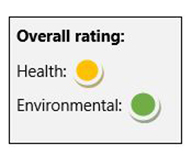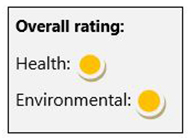Professional garment cleaners are facilities that clean items made of textile fibers (e.g., clothing, apparel, bedding, drapes, etc.) using chemical solvents.1 However, some garment cleaning chemicals pose a greater environmental and human health risk than others.
Do you know what products are being used to clean your clothes? If not, do you know how to find out?
If you answered no to the previous questions, it is especially important for you to learn how to make informed decisions about where you take your garments to be cleaned.
On June 1, 2016, Suffolk County adopted a local law to increase awareness of the chemical solvents used in professional garment cleaning. To help consumers make safer informed choices, Suffolk County Local Law 15-2016 requires that every professional garment cleaning establishment (including dry cleaners) post a sign that informs customers about the chemical solvents used at the cleaner.

The sign, created by environmental professionals in the Department of Health Services, is based on a review of potential health and environmental concerns of chemicals used in various garment cleaning techniques available at the time of review.3
The following six solvents and cleaning techniques were identified, assessed, and categorized based on human health and environmental factors:
- Perchloroethylene (Perc)
- High Flash Point Hydrocarbons
- Wet Cleaning
- Siloxane
- Liquid Carbon Dioxide
- Butylal (aka SolvonK4)
To learn more about SCDHS evaluation of these garment cleaning chemicals: View the report
What Do the Colors Mean?
The sign includes consumer choice categories based on human health and environmental factors. The categories are color coded ranging from red to green.3

If you believe a garment cleaner is not posting the sign according to the law, you can notify the SCDHS at 631-854-2501.
Perchloroethylene (also known as Perc), is a nonflammable colorless liquid that is used in many industries.4 It evaporates easily into the air and has a sweet, ether-like odor.5 It has been used in dry cleaning since the 1960s and is the most common solvent used for garment cleaning in the United States.6 However, the U.S Environmental Protection Agency (US EPA) classifies Perc as a “probable” human carcinogen that may pose serious health risks upon exposure and environmental impacts.7 The EPA proposed a ban on all consumer and many business uses of Perc in June 2023.8 This includes banning the use of perc for dry-cleaning purposes to eliminate an “unreasonable risk to health” in those who use, work in, and live near dry cleaners.8
For more information on the EPA’s recent Perc ban proposal visit: https://www.epa.gov/newsreleases/epa-proposes-ban-all-consumer-and-many-commercial-uses-perchloroethylene-protect
Exposure
People may be exposed to Perc in air, water, soil, and food. In most cases, almost all exposure is from breathing Perc contaminated air.9 Evaporation from dry-cleaning facilities and areas where chemical waste is stored or disposed is usually how Perc gets into outdoor and indoor air.9
Perc chemical breaks down very slowly in the air and as a result it can be transported long distances.4 In the home, dry-cleaned clothes can release small amounts of Perc. The US EPA advises that consumers not accept clothing back from a cleaner if it has a strong odor.10
Environmental Impact
Perc is a persistent pollutant that can contaminate air, soil, soil vapor, groundwater, drinking water, and is potentially toxic to wildlife.
Human Health Impact
Breathing high concentrations of Perc, especially in closed poorly ventilated areas, can cause5,11:
- Headache, sleepiness, and lightheadedness.
- Dizziness, drowsiness, confusion, and loss of coordination.
- Eye, nose, and upper respiratory tract irritation.

Studies suggest long-term exposure can result in adverse effects in several parts of the body, including the kidney, liver, and immune system.5
- Exposure may also increase the risk of getting certain types of cancer.12
- Negative effects on pregnancy and unborn children are also possible.5
- Those who live or work near garment cleaning facilities that use Perc may be exposed to higher levels than those who do not.9,11.
Now that you know the negative impacts that Perc can have on your health and the environment, what can you do as a consumer?
- Look for a professional garment cleaner that uses safer alternatives to Perc. Continue reading to learn more about Perc alternatives.
- If you use a dry cleaner that uses Perc, be sure to take your garments out of the bag and air them out outdoors before bringing them into your home.
While most professional garment cleaners use Perc as a cleaning solvent, there are healthier alternatives available. If your garment cleaner uses Perc, consider going to one that uses one of these alternatives.
Many dry cleaners may use words like “green”, “organic”, “eco-friendly”, etc.
Although these terms might mean they are using a healthier alternative to Perc, these terms don’t identify what specific solvents are being used so it’s important to refer to the sign or ask.
Liquid Carbon Dioxide Cleaning
Liquid carbon dioxide (CO2) is a nonflammable, nontoxic, odorless gas that exists in nature. In this cleaning method, pressurized liquid CO2 is used in combination with gentle specialized detergents.3 The liquid CO2 cleaning process is efficient at removing stains (especially oil-based ones) and has minimal risk of damaging garments.13

Advantages:
- Non-toxic.
- Gentle on garments and effective at removing stains.
- No carcinogenic chemicals encounter your skin or clothes.
- No release to soil or water expected and no environmental contamination.
- No new CO2 is generated so it does not contribute to global warming.
- No health concerns expected.
Disadvantages:
- Cost for CO2 dry cleaning machine is high, so few cleaners are adopting this technique.
Professional Wet Cleaning
Professional wet cleaning is a process that uses water as the solvent along with detergents and special machines to clean garments.6 These innovative computer-controlled machines are highly advanced which is why most clothing labeled “dry clean only” can be cleaned in this process.3,13. The only disadvantage to wet cleaning is that it produces wastewater, which needs to be discharged properly.3 However, it is considered a professional garment cleaning process with one of the lowest health and environmental concerns, as well as the most energy-efficient method.14

Advantages:
- Biodegradable.
- No hazardous chemicals used.
- Air pollution is not expected.
- No health concerns expected since the solvent used is water.
- Wet-cleaned clothes are free from chemical odor unlike dry-cleaned clothes.15
- Energy efficient; consumes about 50% less energy than dry-cleaning.15
- Water is gentler than other solvents on garments.
Disadvantages:
- Can lead to groundwater contamination if not discharged appropriately.3
Butylal (aka Solvon K4)
Butylal is a colorless solvent (at room temperature) used in SolvonK4. It is considered a volatile organic compound (VOC), which means it has the potential to lead to inhalation exposures.3 However, the NYS Department of Environmental Conservation concludes that annual air concentration levels (outdoor and indoor) are predicted to be low in homes near garment cleaners that use Butylal.3
Advantages:
- Biodegradable.
- Exposure through drinking water and food (such as fish) is low.
- Low tendency to bioaccumulate.
- Not persistent in air, water, or soil.
- Not expected to be toxic to aquatic organisms.
Disadvantages:
- Toxicity information lacking.
- It’s unknown whether formaldehyde (a substance capable of causing cancer; carcinogen) is present as a breakdown product.

Liquid Siloxane (GreenEarth, Siloxane D5)
Siloxane is an odorless, colorless, liquid that has low solubility in water.3 The US EPA does not recognize this substance as a potential carcinogen (substances that can cause cancer).6 Siloxane is also fabric gentle and has been used in many consumer goods such as deodorants, shampoos, moisturizing creams, and other personal care products.16
Advantages:
- Completely odorless and extremely gentle.
- Low persistence in water.
- Not considered hazardous waste.
- No associated human health effects.
- Exposure to those living near garment cleaners using Siloxane may not pose a risk.

Disadvantages:
- Evidence of bioaccumulation.
- Persistent in sediment, air and moderately persistent in soil.
- High aquatic toxicity.
- Evidence of endocrine disruption and developmental toxicity.
High Flash Point Hydrocarbons
High flash point hydrocarbons are frequently used as a solvent in dry cleaning establishments. These hydrocarbons are a class of low-odor, petroleum-based chemicals that ignite at relatively high temperatures (greater than 140°F), hence why they are called “high flash point”.3 They contain only carbon and hydrogen, hence the classification “hydrocarbons”.
This type of technology is one of the most widely used alternatives to Perc garment cleaning because it is most similar.14,17. In 1998, the US EPA conducted an evaluation and concluded that there was a low level of concern for health risks from inhalation exposures to hydrocarbon solvents used in dry cleaning.3 However, other studies have shown that high concentrations of hydrocarbons can cause headaches, dizziness, skin, and eye irritation for workers.13,14.
Advantages:
- Biodegradable.
- Not persistent in water.
- Low level concern for health risks.
- Non-carcinogenic.17
- Less aggressive on garments than Perc and effective on delicate clothing.

Disadvantages:
- Moderately persistent in sediment.
- High aquatic toxicity.
- Some evidence of reproductive effects.
- Skin irritant.
- Possibility of bioaccumulation.
More Information
Sample Safety Data Sheets for Garment Cleaning Chemicals